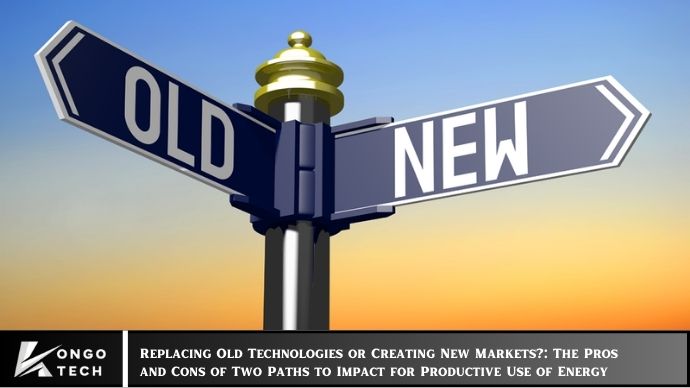Energy consumption is one of the most critical issues in today’s world. As the global demand for energy continues to rise and the environmental impact of traditional energy sources becomes increasingly unsustainable, there are two primary pathways for achieving productive energy use: replacing old technologies with more energy-efficient alternatives, or creating new markets that harness innovative solutions and drive energy consumption in more sustainable directions.
Both strategies present unique opportunities and challenges, and the best approach depends on numerous factors, including technological advancements, market dynamics, environmental goals, and political will. In this post, we will explore the pros and cons of these two distinct paths to better energy use and discuss how businesses, governments, and innovators can navigate them to maximize energy productivity and minimize environmental harm.
Path 1: Replacing Old Technologies
The first path to enhancing energy productivity involves replacing outdated or inefficient technologies with modern alternatives that are designed to use energy more effectively. This approach can be applied across various sectors, from manufacturing to transportation, and aims to reduce the energy footprint of existing systems.
Pros of Replacing Old Technologies
- Immediate Efficiency Gains One of the main benefits of replacing outdated technologies is that it can lead to immediate and tangible improvements in energy efficiency. Newer systems are often designed with energy conservation in mind, whether through advanced insulation, better energy management systems, or optimized energy consumption controls.For example, switching from incandescent bulbs to energy-efficient LED lights can drastically reduce electricity use without requiring major changes to existing infrastructure.
- Cost Savings in the Long Term While replacing old technologies may require an initial investment, the long-term cost savings can be substantial. Modern technologies tend to be more energy-efficient, which means that over time, companies or consumers can save money on their energy bills.
- Sustainability and Reduced Carbon Footprint Replacing inefficient technologies with greener alternatives directly reduces the carbon footprint of industries and households. Using renewable energy sources or highly efficient appliances contributes to environmental sustainability by lowering greenhouse gas emissions.
- Fostering Innovation The constant need to improve and replace outdated technologies can drive innovation in the energy sector. With new solutions constantly emerging, industries are encouraged to adopt cutting-edge technologies that lead to more sustainable and energy-efficient systems.
- Regulatory Compliance Governments around the world are tightening regulations around energy consumption and carbon emissions. By replacing old technologies with energy-efficient systems, businesses can ensure they meet these increasingly stringent standards and avoid potential fines or penalties.
Cons of Replacing Old Technologies
- High Upfront Costs One of the significant downsides of replacing old technologies is the upfront cost. While the long-term savings can justify the expense, initial investments in new equipment, systems, or infrastructure can be significant, particularly for industries that require large-scale changes.
- Disruption to Existing Systems Implementing new technologies can be disruptive. Businesses that replace old systems may experience downtime, training requirements, and operational disruptions during the transition period. For sectors where uptime is critical, this can lead to lost productivity and revenue.
- Obsolescence of Legacy Systems Older technologies may be integrated with other systems, and replacing one element can create challenges in terms of compatibility or system obsolescence. The process of phasing out legacy technologies needs careful planning to ensure continuity and prevent disruptions.
- Lack of Awareness or Resistance to Change In some industries or regions, there may be a resistance to replacing older technologies. The people and organizations involved might be comfortable with the status quo, which can slow the adoption of more efficient and sustainable technologies.
Path 2: Creating New Markets
The second path to optimizing energy use involves creating entirely new markets that tap into emerging technologies or services designed to use energy more efficiently or produce it sustainably. This strategy goes beyond replacing old technologies and focuses on creating entirely new ecosystems for energy use.
Pros of Creating New Markets
- Encourages Breakthrough Innovation By creating new markets, there is often the potential to foster breakthrough innovations that can lead to more sustainable energy solutions. For example, the rise of solar energy, electric vehicles (EVs), and smart grids have all created entirely new markets with the potential to disrupt traditional energy paradigms.
- Long-Term Sustainability The creation of new markets often targets foundational changes in how energy is produced, distributed, and consumed. For example, the development of decentralized renewable energy markets or innovations in battery storage can provide long-term, sustainable solutions for energy use across the globe.
- Economic Growth and Job Creation New markets can lead to the creation of jobs and new economic opportunities. Whether it’s the development of new energy technologies or the expansion of sustainable infrastructure, new industries can stimulate growth in regions that embrace them, providing long-term prosperity.
- Flexibility in Market Structure Creating new markets allows for a high degree of flexibility in terms of design, technology adoption, and regulatory frameworks. This flexibility can make it easier to introduce innovative technologies or integrate new trends without being constrained by legacy systems.
- Global Reach New energy markets, particularly in emerging economies, can be more easily scaled globally. For instance, solar energy technology can be introduced in regions with limited access to traditional energy infrastructure, providing energy access to off-grid areas and contributing to broader global sustainability goals.
Cons of Creating New Markets
- Uncertainty and Risk Creating new markets is inherently risky. There is no guarantee that new markets will succeed or that the technologies driving them will be scalable. For example, while hydrogen fuel cells or certain biofuels hold promise, the market for these technologies is still in its infancy and may not take off as expected.
- High Investment Needs Building new markets often requires substantial financial backing. Whether it’s the creation of new infrastructure or the funding of innovative research and development (R&D), the capital required to build these markets can be immense.
- Lack of Established Infrastructure Unlike replacing old technologies, creating new markets often means developing entirely new infrastructure from the ground up. This requires careful planning and coordination across different sectors—energy, policy, technology, and finance—making it a complex undertaking.
- Regulatory Challenges New markets can face regulatory hurdles as governments may not have established frameworks for emerging technologies. Navigating these regulatory environments can be slow, particularly when there are political or industry stakeholders resistant to change.
- Adoption Barriers New markets require consumer and industry adoption, which can take time. Even if a new technology or service is created, it may take years before it reaches critical mass and gains widespread acceptance, especially if it competes with well-established technologies.
Which Path is Right for You?
Both paths—replacing old technologies and creating new markets—offer distinct advantages for improving the productive use of energy. The decision between them depends largely on the specific circumstances, such as the resources available, the urgency of energy efficiency goals, and the existing infrastructure.
- Replacing old technologies is often the most immediate and tangible option, especially in industries with large existing infrastructures, where making incremental improvements can yield rapid efficiency gains.
- Creating new markets, on the other hand, is more suited to those seeking long-term, transformative changes that have the potential to disrupt entire industries and create new, sustainable ecosystems for energy use.
May you also like it:
VMware® Certified Professional: Data Center Virtualization 2023 (VCP-DCV 2023) – A Complete Guide
Understanding How R&D Capitalization Works
Scrum vs Safe: Major Differences You Must Know
FAQs
What is the main difference between replacing old technologies and creating new markets for energy? Replacing old technologies focuses on improving existing systems for better energy use, while creating new markets involves introducing innovative solutions and systems that could revolutionize energy consumption.
Which approach is more cost-effective in the short term?
Replacing old technologies is generally more cost-effective in the short term, as it involves upgrading or replacing existing systems rather than building new infrastructures from scratch.
Are there any downsides to creating new markets for energy?
Yes, creating new markets involves high investment, uncertainty, and challenges with infrastructure and regulation. It may also take longer for new technologies to be adopted.
Can replacing old technologies contribute to sustainability?
Yes, replacing old technologies with energy-efficient alternatives reduces energy consumption and carbon emissions, contributing directly to sustainability goals.
Which strategy is more likely to drive long-term change in energy consumption?
Creating new markets for energy is more likely to drive long-term systemic change, particularly in fostering breakthrough innovations that transform how energy is produced and consumed globally.
Conclusion
Whether you choose to replace old technologies or create new markets, both paths offer unique advantages and challenges for enhancing energy use. The key lies in understanding the specific needs of your industry, the technological landscape, and the long-term goals you aim to achieve. With thoughtful planning and strategic execution, either path can contribute significantly to optimizing energy consumption and driving sustainability in the future.

